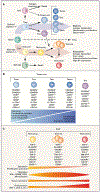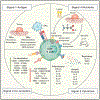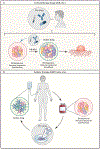CD8+ T cells in the cancer-immunity cycle
- PMID: 37820583
- PMCID: PMC11237652
- DOI: 10.1016/j.immuni.2023.09.005
CD8+ T cells in the cancer-immunity cycle
Abstract
CD8+ T cells are end effectors of cancer immunity. Most forms of effective cancer immunotherapy involve CD8+ T cell effector function. Here, we review the current understanding of T cell function in cancer, focusing on key CD8+ T cell subtypes and states. We discuss factors that influence CD8+ T cell differentiation and function in cancer through a framework that incorporates the classic three-signal model and a fourth signal-metabolism-and also consider the impact of the tumor microenvironment from a T cell perspective. We argue for the notion of immunotherapies as "pro-drugs" that act to augment or modulate T cells, which ultimately serve as the drug in vivo, and for the importance of overall immune health in cancer treatment and prevention. The progress in understanding T cell function in cancer has and will continue to improve harnessing of the immune system across broader tumor types to benefit more patients.
Keywords: CD8 T cells; T cell exhaustion; cancer; immune checkpoint blockade; immunology; immunotherapy; metabolism.
Copyright © 2023 Elsevier Inc. All rights reserved.
Conflict of interest statement
Declaration of interests E.J.W. is a member of the Parker Institute for Cancer Immunotherapy. E.J.W. is an advisor for Danger Bio, Janssen, New Limit, Marengo, Pluto Immunotherapeutics Related Sciences, Santa Ana Bio, and Synthekine. E.J.W. is a founder of Danger Bio and Arsenal Biosciences. J.R.G. is a consultant for Arsenal Biosciences. S.M.K. is on the scientific advisory boards of, and has equity in, EvolveImmune Therapeutics, Affini-T Therapeutics, Arvinas, and Pfizer.
Figures




References
-
- Chen D & Mellman I Oncology meets immunology: The cancer-immunity cycle. Immunity 39, 1–10 (2013). - PubMed
-
- Plitas G & Rudensky AY Regulatory T Cells in Cancer. Annual Review of Cancer Biology 4, 459–477 (2020).
-
- Togashi Y, Shitara K & Nishikawa H Regulatory T cells in cancer immunosuppression — implications for anticancer therapy. Nature Reviews Clinical Oncology 16, 356–371 (2019). - PubMed
-
- Speiser DE, Chijioke O, Schaeuble K & Münz C CD4(+) T cells in cancer. Nat Cancer 4, 317–329 (2023). - PubMed
-
- Kaech SM et al. Selective expression of the interleukin 7 receptor identifies effector CD8 T cells that give rise to long-lived memory cells. Nat Immunol 4, 1191–1198 (2003). - PubMed
Publication types
MeSH terms
Grants and funding
LinkOut - more resources
Full Text Sources
Medical
Research Materials

